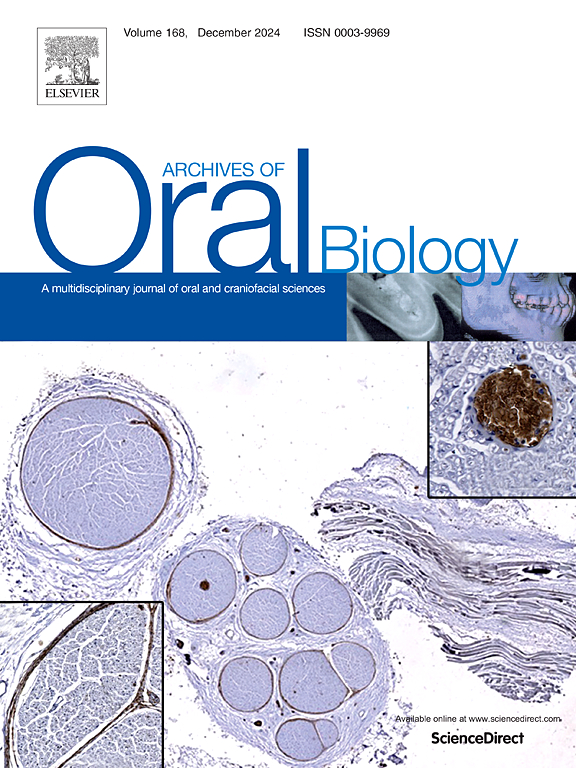肉桂醛在种植体周围黏膜炎模型中的抗菌作用。
IF 2.1
4区 医学
Q2 DENTISTRY, ORAL SURGERY & MEDICINE
引用次数: 0
摘要
目的:评价含1 %肉桂醛实验性漱口水在多微生物生物膜模型中对种植周黏膜炎的抗菌效果。材料和方法:从2名牙周健康供者和2名牙龈炎患者的刺激唾液中采集样本,在氧化锆和钛(n = 6或8/组)表面播种多微生物生物膜。60 min进行唾液腺膜检查。接种物(1 ×108 CFU/mL)在McBain培养基(1 %蔗糖)中播种。氧化锆上的生物膜在好氧条件下培养,钛上的生物膜在微氧条件下培养24 h。每日添加10 %蔗糖。将样品暴露于实验漱口水中1 min,每天两次,持续72 h。以浓度为0.12 %的二光酸氯己定和浓度为0.9 %的生理盐水为对照。生物膜在培养中再保存24 h,以计数活细胞,评估生物量和细胞代谢。结果:在氧化锆中,细胞代谢评价在生物膜条件下没有发现统计学差异(p > 0.05)。结果发现,与阴性对照相比,1 %肉桂醛漱口水对多微生物生物膜的抗菌作用与氯己定相似(p )。本文章由计算机程序翻译,如有差异,请以英文原文为准。
Antimicrobial effect of cinnamaldehyde in a peri-implant mucositis model
Objective
Evaluate the antimicrobial effect of an experimental mouthwash containing 1 % cinnamaldehyde in a polymicrobial biofilm model for peri-implant mucositis.
Materials and methods
Polymicrobial biofilms were seeded on zirconia and on titanium (n = 6 or 8/group) surfaces from stimulated saliva collection from 2 periodontal health donors and 2 with gingivitis. Salivary pellicle was performed, by 60 min. Inoculum was seeded (1 ×108 CFU/mL) in McBain medium (1 % of sucrose). Biofilms on zirconia were cultured in aerobiosis and on titanium in microaerophilic conditions for 24 h. Daily challenges with 10 % sucrose were stablished. Samples were exposed to the experimental mouthwash for 1 min, twice a day, for 72 h. Chlorhexidine digluconate at 0.12 % and saline solution (at 0.9 %) were used as controls. Biofilms were kept in culture for an additional 24 h to count viable cells, evaluate biomass and cellular metabolism.
Results
In zirconia, evaluation of cellular metabolism did not detect a statistically significant difference between the biofilm conditions (p > 0.05). It was found that cellular metabolism was decreased from exposure to mouthwash and chlorhexidine, with a difference compared to the negative control (p < 0.05). In titanium, viable cell count in two media and the biomass were higher for biofilms from the periodontal health salivary condition (p < 0.05). There was a decrease in the biomass of biofilms exposed to the experimental mouthwash for both salivary conditions. Metabolic activity was decreased when exposed to experimental mouthwash and chlorhexidine compared to the negative control (p < 0.05).
Conclusions
Experimental mouthwash with 1 % cinnamaldehyde showed an antimicrobial effect similar to chlorhexidine against polymicrobial biofilms.
求助全文
通过发布文献求助,成功后即可免费获取论文全文。
去求助
来源期刊

Archives of oral biology
医学-牙科与口腔外科
CiteScore
5.10
自引率
3.30%
发文量
177
审稿时长
26 days
期刊介绍:
Archives of Oral Biology is an international journal which aims to publish papers of the highest scientific quality in the oral and craniofacial sciences. The journal is particularly interested in research which advances knowledge in the mechanisms of craniofacial development and disease, including:
Cell and molecular biology
Molecular genetics
Immunology
Pathogenesis
Cellular microbiology
Embryology
Syndromology
Forensic dentistry
 求助内容:
求助内容: 应助结果提醒方式:
应助结果提醒方式:


